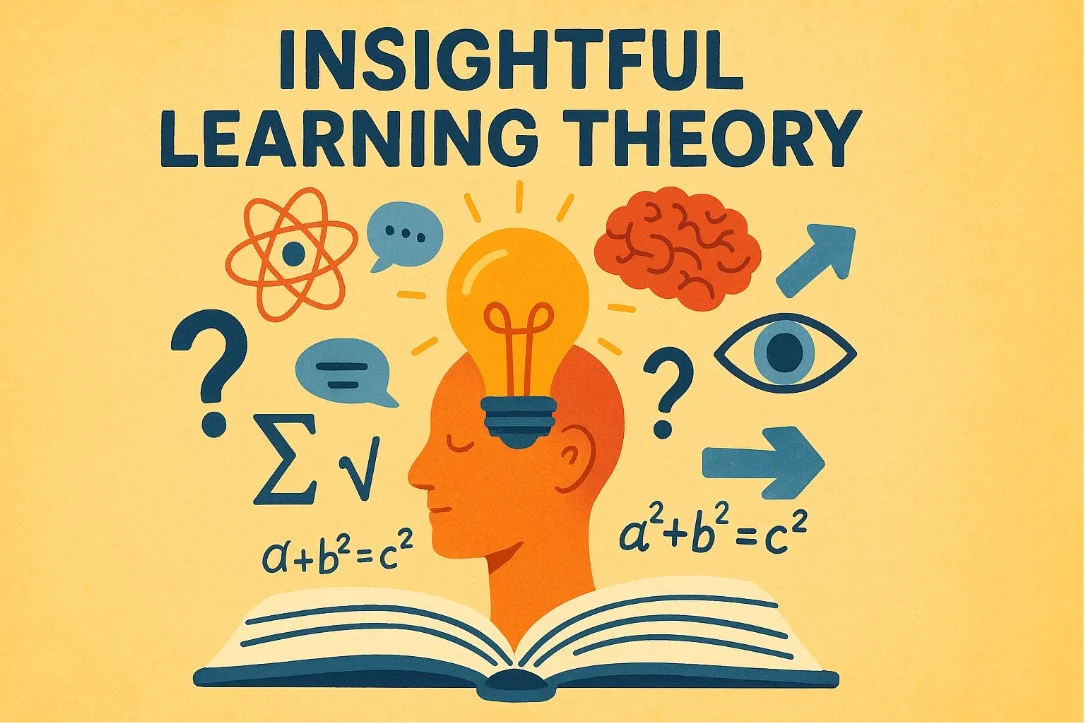Introduction
Learning is a complex process, and psychologists have developed various theories to explain how we acquire knowledge. One such influential theory is Insightful Learning Theory, which emphasizes the role of sudden understanding or “aha moments” in learning. Unlike trial-and-error methods, insightful learning involves grasping a problem’s solution in a sudden, intuitive way.
In this article, we’ll explore Insightful Learning Theory, its origins, key principles, applications, and how it differs from other learning theories. Whether you’re a student, educator, or lifelong learner, understanding this concept can enhance how you approach problem-solving and knowledge acquisition.
What Is Insightful Learning Theory?
Insightful Learning Theory was introduced by German psychologist Wolfgang Köhler in the early 20th century. Köhler conducted experiments with chimpanzees, observing how they solved problems not through repetitive trial-and-error but through sudden realizations.
Key Characteristics of Insightful Learning:
-
Sudden Understanding – Solutions appear abruptly rather than through gradual steps.
-
Cognitive Restructuring – The learner reorganizes information to see the problem differently.
-
Application to New Situations – Once insight is gained, it can be applied to similar problems.
-
Internal Process – It happens internally, often without external reinforcement.
Unlike behaviorist theories (like Skinner’s operant conditioning), which focus on external rewards and punishments, Insightful Learning Theory highlights internal cognitive processes.
How Insightful Learning Works
1. The Role of Perception
Insightful learning depends on how we perceive a problem. When the mind restructures information, the solution becomes clear. For example, when solving a puzzle, you might suddenly see a pattern that wasn’t obvious before.
2. Past Experience & Mental Associations
Previous knowledge helps in forming insights. The brain connects past experiences with current problems, leading to sudden solutions.
3. The “Aha!” Moment
This is the defining feature of insightful learning—when everything “clicks” without conscious step-by-step reasoning.
4. Testing the Solution
After an insight, the learner tests whether the solution works, reinforcing the learning process.
Examples of Insightful Learning
1. Köhler’s Chimpanzee Experiment
Köhler placed a banana out of reach and provided sticks and boxes. Initially, the chimps struggled, but suddenly, one stacked the boxes to reach the banana—demonstrating insight rather than trial-and-error.
2. Human Problem-Solving
-
Math Problems – Struggling with an equation before suddenly seeing the solution.
-
Creative Work – Writers or artists experiencing a breakthrough idea.
-
Everyday Life – Figuring out a shortcut in traffic after analyzing the route differently.
Insightful Learning vs. Other Learning Theories
| Theory | Focus | Key Mechanism |
|---|---|---|
| Insightful Learning | Sudden understanding | Cognitive restructuring |
| Behaviorism | External rewards/punishments | Conditioning (Pavlov, Skinner) |
| Cognitive Learning | Information processing | Memory, reasoning |
| Constructivism | Building knowledge from experience | Active engagement & reflection |
While behaviorism focuses on external stimuli, Insightful Learning Theory emphasizes internal realization.
Applications of Insightful Learning Theory
1. Education
-
Encouraging critical thinking over rote memorization.
-
Using puzzles, open-ended questions, and brainstorming to stimulate insights.
2. Workplace Training
-
Problem-solving workshops that promote sudden realizations.
-
Encouraging employees to think creatively rather than follow rigid procedures.
3. Therapy & Counseling
-
Helping clients gain sudden clarity about their behaviors or emotions.
-
Cognitive restructuring techniques in psychotherapy.
4. Artificial Intelligence (AI)
-
AI models that simulate human-like insight in problem-solving.
How to Foster Insightful Learning
-
Encourage Exploration – Allow learners to experiment with different approaches.
-
Present Problems in New Ways – Changing the problem’s framing can trigger insights.
-
Promote Relaxation – Stress blocks insight; a relaxed mind is more open to sudden realizations.
-
Use Analogies & Metaphors – Connecting unrelated ideas can spark insights.
Criticisms & Limitations
While Insightful Learning Theory is valuable, it has some limitations:
-
Not Always Predictable – Insights are spontaneous and hard to replicate.
-
Depends on Prior Knowledge – Without foundational knowledge, insights may not occur.
-
Difficult to Measure – Unlike behaviorist methods, insights are subjective.
Conclusion
Insightful Learning Theory provides a fascinating perspective on how we solve problems through sudden understanding rather than gradual conditioning. From education to AI, its applications are vast, emphasizing the importance of cognitive restructuring and creativity in learning.
By fostering environments that encourage exploration and reflection, we can harness the power of insightful learning to enhance problem-solving skills in everyday life.
Frequently Asked Questions (FAQs)
1. How is insightful learning different from trial-and-error learning?
Insightful learning involves sudden understanding, while trial-and-error relies on repeated attempts. Insight is quicker and based on cognitive restructuring rather than gradual reinforcement.
2. Can insightful learning be taught?
While insights are spontaneous, educators can create conditions that promote them—such as using open-ended questions, puzzles, and encouraging creative thinking.
3. Is insightful learning only for humans?
No, Köhler’s experiments with chimpanzees proved that animals also experience insightful learning. Some AI models also simulate insight-based problem-solving.
By understanding Insightful Learning Theory, we can better appreciate the “aha moments” that shape how we learn and innovate.
Know More : What is Insightful
